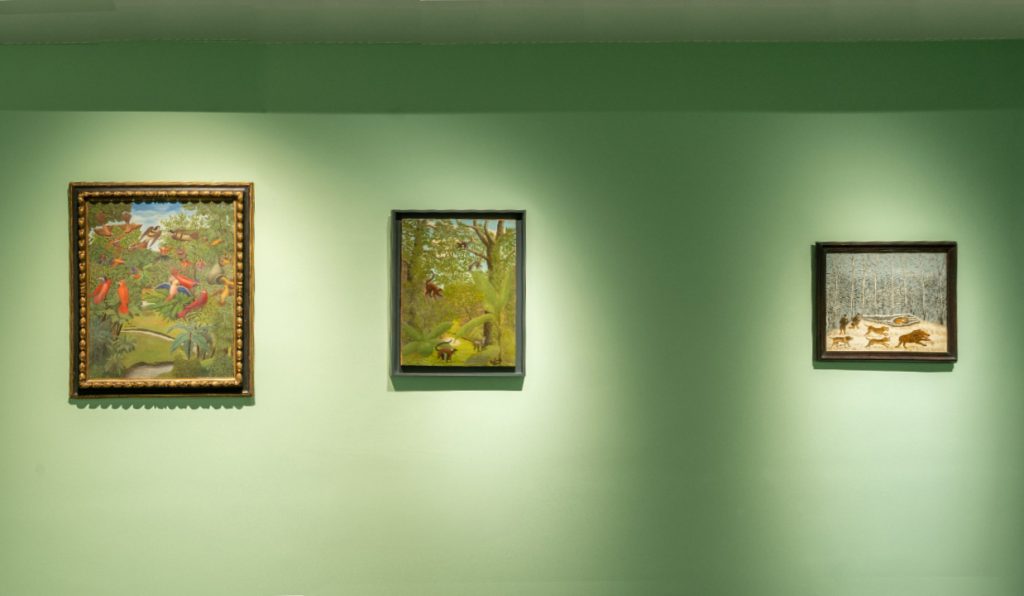En cours
A Venir
Billetterie
Collections en ligne
Actualités
Boutique
Restaurants et privatisation
04.09.2023
Showcasing Naïve Art on the Chinese Stage
Every summer, the Jiushi Art Museum dedicates an exhibition to a significant artist, such as Edvard Munch, Marc Chagall, or Giorgio Morandi. This presentation invites the public, especially children, to explore the works of a master. For its fourth edition, the focus is on a Western art movement: Naïve painters.
A total of nine artists are featured: André Bauchant, Camille Bombois, Ferdinand Desnos, Séraphine Louis, Dominique Peyronnet, René Rimbert, Henri Rousseau, and Louis Vivin. None of them received formal artistic training, and they all pursued different professions: Henri Rousseau worked in customs, Séraphine Louis was a housekeeper, Camille Bombois was a wrestler, and so on. The group began to emerge in the late 19th century. Their art is characterized by a deliberate abandonment of perspective, the use of vibrant colors, and the representation of popular subjects. Often, these artists were labeled as “amateurs” or “childish,” which led to their being viewed as part of minor art. It’s only in recent years that they have experienced a renewed interest.

A significant loan
The Jiushi Art Museum exhibits fifty-five works, the vast majority of which come from the Fondation Dina Vierny – Musée Maillol and the Galerie Dina Vierny. Dina Vierny had taken an interest in this group of artists and acquired many of their works.
To enhance the understanding of Naïve art, the presentation is divided into five themes: “Garden’s Dreams,” “The Life of Others,” “The Enchanted City,” “Sunday Tables,” and “Lively Nature.”
Except for Rimbert, who was from Paris, all the artists came from different regions of France. During the Belle Époque, many settled in Paris to seek employment, and the landscapes of the capital captivated them. For example, both Louis Vivin and Jean Eve depicted Sacré-Cœur and its surroundings in Montmartre.

Natural landscapes are also prevalent among Naïve painters, as seen in Rousseau’s jungles, Peyronnet’s maritime views, and Vivin’s hunting scenes. Bauchant, a nurseryman, imagined landscapes populated with animals and plants, infusing his paintings with exoticism. Each artist perceived nature in their own way and depicted it according to their vision.

Vegetation thus plays a significant role in the production of Naïve painters. Several beautiful examples are exhibited, such as Bauchant’s “Bouquet pour Dina”, created in 1957 and dedicated to Dina Vierny. However, the artist prominently featured in this section is Séraphine Louis. As the only woman in the exhibition, her botanical bouquets are tinged with mysticism, captivating visitors.

The human figure also remains an important subject for the group of artists, who enjoyed painting their subjects in relation to their surroundings. While some created portraits of loved ones or illustrious figures, others turned to historical or genre scenes. The exhibition testifies to the variety of subjects that different painters held dear.

Finally, the last theme addressed is the representation of still life. All the artists engaged in this genre, considering it a means to showcase their personal world and skills. Even though they share a common theme, they approach it differently. Bombois, Eve, and Vivin paint tables laden with luxurious dishes. Rimbert, through his works, leans towards vanitas, while those of Louis resemble botanical illustrations.

Thus, this exhibition sheds light on a group of artists who continue to increasingly fascinate the public. The numerous loans from theFondation Dina Vierny – Musée Maillol and the Galerie Dina Vierny attest to this growing interest in painters who have authentically conveyed their emotions.
Find out more about our current exhibtion : Andres Serrano. Portraits of America
DISCOVERMentions légales | CGU | Données personnelles | Gestion des cookies
Musée Maillol, 2021
Mentions légales | CGU | Données personnelles | Gestion des cookies
Musée Maillol, 2021